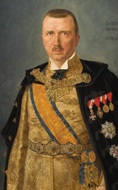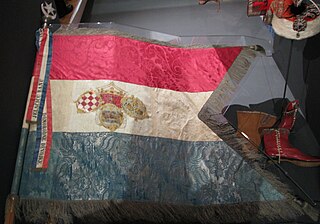
The Croatian Parliament or the Sabor is the unicameral legislature of Croatia. Under the terms of the Croatian Constitution, the Sabor represents the people and is vested with legislative power. The Sabor is composed of 151 members elected to a four-year term on the basis of direct, universal and equal suffrage by secret ballot. Seats are allocated according to the Croatian Parliament electoral districts: 140 members of the parliament are elected in multi-seat constituencies. An additional three seats are reserved for the diaspora and Croats in Bosnia and Herzegovina, while national minorities have eight places reserved in parliament. The Sabor is presided over by a Speaker, who is assisted by at least one deputy speaker.

Nova Gradiška is a town located in the Brod-Posavina County of Croatia, population 14,229 (2011). It is located in the historic region of Slavonia, near the border to Bosnia and Herzegovina.
The Government of Croatia, formally the Government of the Republic of Croatia, commonly abbreviated to Croatian Government, is the main executive branch of government in Croatia. It is led by the president of the Government, informally abbreviated to premier or prime minister. The prime minister is nominated by the president of the Republic from among those candidates who enjoy majority support in the Croatian Parliament ; the candidate is then chosen by the Parliament. There are 20 other government members, serving as deputy prime ministers, government ministers or both; they are chosen by the prime minister and confirmed by the Parliament. The Government of the Republic of Croatia exercises its executive powers in conformity with the Croatian Constitution and legislation enacted by the Croatian Parliament. The current government is led by Prime Minister Andrej Plenković.

The phrase Imperial and Royal refers to the court/government of the Habsburgs in a broader historical perspective. Some modern authors restrict its use to the Dual Monarchy of Austria-Hungary from 1867 to 1918.

Varaždin County was an administrative subdivision (županija) of the Kingdom of Croatia-Slavonia. Croatia-Slavonia was an autonomous kingdom within the Lands of the Crown of Saint Stephen (Transleithania), the Hungarian part of the dual Austro-Hungarian Empire. Its territory is now in northern Croatia. The capital of the county was Varaždin.
Stara Gradiška is a village and a municipality in Slavonia, in the Brod-Posavina County of Croatia. It is located on the left bank of the river Sava, across from Gradiška in Bosnia and Herzegovina.

The Kingdom of Dalmatia was a crown land of the Austrian Empire (1815–1867) and the Cisleithanian half of Austria-Hungary (1867–1918). It encompassed the entirety of the region of Dalmatia, with its capital at Zadar.

Croatian nobility was a privileged social class in Croatia during the Antiquity and Medieval periods of the country's history. Noble families in the Kingdom of Croatia included high ranking populates from Slavonia, Dalmatia, Istria, and Republic of Ragusa. Members belonged to an elite social hierarchy, normally placed immediately behind blood royalty, that possessed considerably more privileges or eminence than most other classes in a society. Membership thereof typically was often hereditary. Historically, membership in the nobility and the prerogatives thereof have been regulated or acknowledged by the monarch. Acquisition of sufficient power, wealth, military prowess or royal favour enabled commoners to ascend into the nobility. The country's royalty was heavily influenced by France's nobility resulting members of the Royal Courts to assume French titles and practices during French occupation. The controversial assumption of French practices contributed to wide spread political and social elitism among the nobles and monarch. The nobility regarded the peasant class as an unseen and irrelevant substrata of people which lead to high causality revolts and beheadings as well as sporadic periods of intense domestic violence.

The Kingdom of Croatia-Slavonia was a nominally autonomous kingdom and constitutionally defined separate political nation within the Austro-Hungarian Empire. It was created in 1868 by merging the kingdoms of Croatia and Slavonia following the Croatian–Hungarian Settlement of 1868. It was associated with the Kingdom of Hungary within the dual Austro-Hungarian state, being within the Lands of the Crown of St. Stephen, also known as Transleithania. While Croatia had been granted a wide internal autonomy with "national features", in reality, Croatian control over key issues such as tax and military issues was minimal and hampered by Hungary. It was internally officially referred to as the Triune Kingdom of Croatia, Slavonia and Dalmatia, also simply known as the Triune Kingdom, and had claims on Dalmatia, which was administered separately by the Austrian Cisleithania. The city of Rijeka, following a disputed section in the 1868 Settlement known as the Rijeka Addendum, became a corpus separatum and was legally owned by Hungary, but administered by both Croatia and Hungary.

The Lands of the Crown of Saint Stephen, informally Transleithania, were the Hungarian territories of Austria-Hungary, throughout the latter's entire existence, and which disintegrated following its dissolution. The name referenced the historic coronation crown of Hungary, known as the Crown of Saint Stephen of Hungary, which had a symbolic importance to the Kingdom of Hungary.

BaronIván Skerlecz de Lomnicza was a Croatian ban (viceroy) between 21 July 1913, until 29 June 1917.

Banski Dvori is a historical building on the west side of St. Mark's Square in Zagreb, Croatia. It served as the official residence of the Croatian Bans (viceroys) and currently houses the Croatian Government.

The Kingdom of Croatia was part of the Lands of the Hungarian Crown, but was subject to direct Imperial Austrian rule for significant periods of time, including its final years. Its capital was Zagreb. It was also a part of the lands of the Habsburg monarchy from 1527, following the Election in Cetin, and the Austrian Empire from 1804 to 1867.
The Tabula Banalis was the supreme court of Croatia. It was established in 1723 by Charles VI, ruler of the Habsburg monarchy. The court was presided over by the Ban of Croatia or by his deputy. For more important trials it was the first instance court, and served as the court of appeal for verdicts of the county courts.

The Croatian–Hungarian Settlement was a pact signed in 1868 that governed Croatia's political status in the Hungarian-ruled part of Austria-Hungary. It lasted until the end of World War I, when the Croatian Parliament, as the representative of the historical sovereignty of Croatia, decided on October 29, 1918 to end all state and legal ties with the old Austria-Hungary.

The Triune Kingdom or Triune Kingdom of Croatia, Slavonia and Dalmatia was the concept—advocated by the leaders of the 19th-century Croatian national revival—of a united kingdom between Croatia, Slavonia and Dalmatia, which were already within the Austrian Empire under one king, who was also the Emperor of Austria, but were politically and administratively separate entities. This concept had roots in the high medieval period, as a successor to the historical Kingdom of Croatia which was made up of those regions.
The minister of Croatian affairs of Hungary was a member of the Hungarian cabinet in Austria-Hungary. The position was created following the Croatian–Hungarian Agreement in 1868. The minister was appointed by the emperor-king. The officeholder kept a connection between Croatia-Slavonia-Dalmatia and the Hungarian Kingdom. This position was without portfolio.
A royal free city, or free royal city, was the official term for the most important cities in the Kingdom of Hungary from the late 12th century to the Hungarian Revolution of 1848.
Antun Kukuljević Sakcinski was a Croatian lawyer, judge and deputy county prefect before being appointed to sit at the Royal Court Table from 1831 to 1850. Kukuljević Sakcinski was a member of the Croatian Sabor and one of Croatian appointed delegates to the Diet of Hungary sittings in 1825 and 1832–1836.












